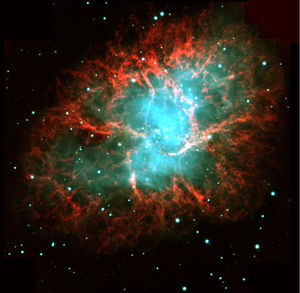A supernova is an enormous explosion and the final evolutionary state of a massive star (more than 6 solar masses). During this explosion, the luminosity of a supernova is tens of billion of times higher than a young star. The energy emitted in such a small time is gigantic and the star is completely destroyed.
A could of gas remains after the explosion and it quickly expands around the star residue. If the mass of the stellar corpse is between 1,4 and 3 solar masses, it forms a neutron star which radius is about 10 km. An example is the pulsar of the Crab Nebula. If the mass of the star corpse is more than 3 times the solar mass, the star will collapse into become a black hole from where nothing, not even light, can escape.

M1 - Crab Nebula
Other deep sky objects: